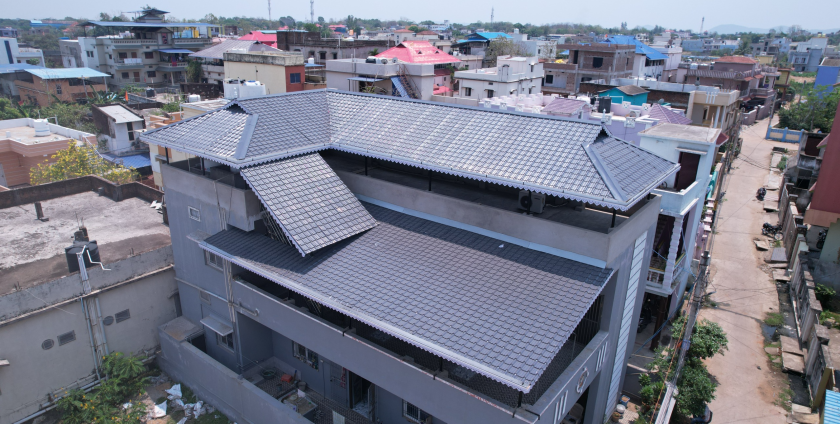
When it comes to protecting your home, one of the most important decisions you’ll make is selecting the right roof. Your roof not only safeguards your home from the elements but also adds to its overall aesthetic and value. With so many options available, choosing the right roofing material can feel overwhelming. However, with the right knowledge, you can make an informed decision that balances style, durability, and functionality.
Here’s a guide on how to choose the right roof for your home:
1. Consider Your Climate
The climate in your region plays a significant role in determining the best roofing material for your home. For example, if you live in a hot, sunny area, a reflective roof material like metal or shingles with reflective coatings can help reduce cooling costs by reflecting the sun’s rays. On the other hand, if you live in an area prone to heavy snow or rain, you’ll want a material that can withstand moisture and prevent leaks, such as asphalt shingles or clay tiles.
2. Evaluate Durability and Lifespan
Different roofing materials have different lifespans. If you’re planning to stay in your home for many years, it’s important to choose a roof that offers long-lasting durability. For instance:
-
Asphalt shingles are a popular choice due to their balance of affordability and durability, typically lasting up to 30 years.
-
Metal roofing offers superior longevity, lasting upwards of 50 years, and is resistant to extreme weather conditions.
-
Clay or concrete tiles are known for their longevity and can last 50+ years, making them a great long-term investment.
Choosing a material with a longer lifespan can save you money in the long run by reducing the need for frequent repairs or replacements.
3. Match the Roof to Your Home’s Style
The style and design of your home should influence your roof choice. For instance:
-
Traditional Homes: Asphalt shingles or wood shakes work well with most traditional-style homes.
-
Modern or Contemporary Homes: Metal roofs are sleek and complement modern architecture.
-
Mediterranean or Spanish Homes: Clay tiles are perfect for creating that rustic Mediterranean look.
Consider the overall aesthetic of your home and how the roof material will complement it. The right roof can enhance the curb appeal of your home and increase its value.
4. Weigh the Costs
Cost is always an important factor when choosing a new roof. While some roofing materials may require a higher initial investment, others may provide long-term savings through durability and energy efficiency. For example, metal roofing may cost more upfront but has a much longer lifespan, reducing future maintenance costs. Asphalt shingles are an affordable and widely used option, offering solid performance for many years.
Make sure to consider both the installation and maintenance requirements of each material to determine which option best fits your budget and long-term needs.
5. Think About Maintenance
Different roofing materials require varying levels of maintenance. For example:
-
Asphalt shingles: These are relatively low-maintenance but may need to be replaced after some years due to general wear.
-
Metal roofs: Known for their low-maintenance nature, metal roofs require little upkeep, often needing only occasional cleaning.
-
Wood shakes: These may require regular treatments to prevent moss, algae, and insect damage.
-
Clay tiles: While generally low-maintenance, clay tiles can be fragile and may break under extreme weather, requiring periodic checks.
Choose a roof that aligns with your willingness to maintain it over time. If you prefer low-maintenance options, materials like metal or asphalt may be ideal.
6. Consider Energy Efficiency
An energy-efficient roof can help reduce your home’s heating and cooling costs. Look for roofing materials that reflect sunlight, absorb heat, or provide better insulation. Some energy-efficient roofing options include:
-
Cool roofing: Reflective coatings or materials that help reduce heat absorption and maintain comfortable indoor temperatures.
-
Insulated roofing: Helps reduce heat transfer, keeping your home cooler in the summer and warmer in the winter.
-
Green roofs: Vegetative roofs that naturally provide insulation and help manage stormwater, contributing to a more eco-friendly home.
By choosing energy-efficient roofing, you can create a more sustainable home while reducing your energy bills.
Conclusion
Choosing the right roof for your home is an investment in its future. From considering your local climate and durability needs to factoring in style, cost, and energy efficiency, there are many aspects to weigh. By understanding the different roofing materials and how they fit with your home’s needs, you can make an informed decision that will protect your home for years to come.
If you’re ready to choose the perfect roof for your home, contact us today for expert advice and professional installation services!
- By: soft_roofing
- 0 comment

Leave a Reply